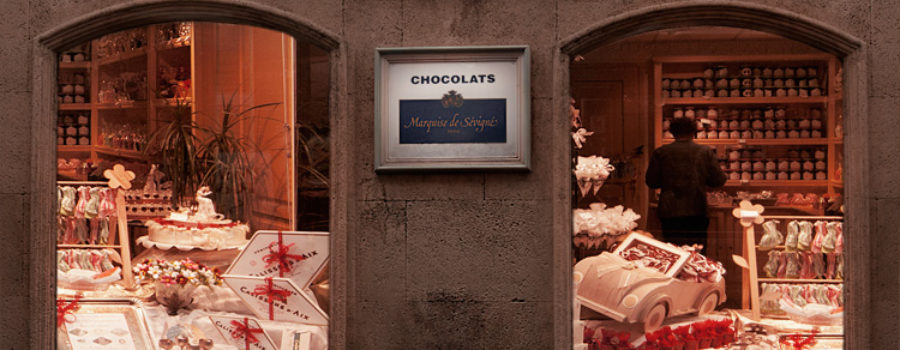French Cooking Terms – Part 1, A-D
Part 1, A-D.
We have compiled a list of French cooking terms translated for better understanding in the English language:
French Cooking Terms (Part 2, E-M)
French Cooking Terms (Part 3, N-Z)
French Cooking Terms beginning with A
Aïoli: (i -o-lee) A Provençal sauce made of garlic, olive oil, usually egg yolks, and seasonings.
A Blanc: French for “in white”. Usually used to describe cream sauces, or meats that are prepared without browning them.
Affriander: A French term for a stylish and appetizing presentation of a dish.
Affrioler: A French term for enticing ones guests to the table with hors d’oeuvres or small samplings.
á la meuniere: This translates as “in the style of the millers wife”, and refers to fish that is floured, sautéed in butter, and then served up with the butter, lemon juice and some parsley.
á la mode: (ah-la-mode) (in the style of) means served with ice cream Anglaise, a l’: A dish poached or boiled, or covered in breadcrumbs and fried.
Amuse-bouche: A French term meaning “Amuse the mouth”. Also known as, amuse-gueule, amusee, petite amuse, and lagniappe. These are small samplings of food served before a meal to whet the appetite and stimulate the palate.
Andouille: a kind of pork sausage.
aperitif: an alcoholic drink served before a meal.
auberigine: eggplant.
au gratin: In French, “au gratin” refers to anything that is grated and put on top of a dish, like breadcrumbs or cheese. In English, au gratin means “with cheese.”
au jus: Jus(with juice) Meat served “au jus” is meat served with the meat’s natural juices.
au naturel: natural or pure, unseasoned.
Au Poivre: A French term meaning “with pepper”, typically describing meats either prepared by coating in coarse ground peppercorns before cooking or accompanied by a peppercorn sauce.
French Cooking Terms beginning with B
Baveuse: refers to the consistency found at the centre of a perfectly cooked omelette, French style; deliciously moist but not quite runny, unctuous.
Baba au rhum: sponge cake soaked in rum syrup.
Baguette: classic long, thin loaf of bread.
Bavarois: A creamy pudding made with cream and eggs, then set using gelatin.
Bâtard: long, thin loaf of bread, larger than a baguette. Batterie de Cuisine – A French term for the various utensils and equipment necessary for a proper kitchen.
Béanaise: a rich white tarragon-flavored sauce. Other ingredients include egg yolks, butter, shallots, white wine, vinegar; and other herbs.
Béchamel: a savory white sauce, made with butter, flour, and milk, usually flavored with onion, bay leaf, pepper, and nutmeg.
Beurre Manié: Butter and flour mixed together in equal parts and used to thicken stews, soups, and casseroles.
Blanch: to cook food lightly in boiled water, a technique which makes the peeling of some fruits and vegetables very easy.
Blanc-Manger: a sweetened milk pudding thickened with corn starch or gelatin and flavored, often with almond.
Bisque: A smooth, creamy soup made from a base of shellfish stock.
Blanquette: A stew made from meat that has not been browned or fried. Usually refers to stews made of lamb, chicken or veal. To burn a food to caramelize the sugar on a foods surface.
Bleu: A French term for a cut of meat cooked only until warmed through, or very rare.
Blondir: A French term for lightly browning food in a fat. Meats and flour (to produce roux) are cooked in this fashion.
Bon Appétit: (good appetite) Enjoy your meal.
Bonbon: (good-good) a candy or sweet.
Bonne Femme: A French phrase describing food prepared uncomplicated and simple or rustic.
Bordelaise: served with a brown sauce. Ingredients may include red wine, onions or shallots, and bone marrow.
Bouillabaisse: popular Mediterranean fish soup, most closely identified with Marseille, ideally prepared with fresh local fish, cooked in a broth of water, olive oil, onions, garlic, tomatoes, parsley, and saffron. Expensive shellfish may be added in restaurant versions, but this practice is considered inauthentic by some.
Bouillon: stock or broth.
Bouchées: Small puff pastry cases with a savoury filling, usually served as an Hors d’Oeuvre.
Bouquet Garni: A mixture of fresh herbs tied together with string and used to flavour stews, soups etc. It refers to a mix of parsley, bay leaf, thyme (and sometimes celery stalk). The bouquet is removed before serving.
Brimont: A French term used when describing a decorative dish that a chef has dedicated to his master.
Brioche: buttery, egg-enriched yeast bread.
Brule: To burn a food to caramelize the sugar on a foods surface.
Brunoise: Vegetables cut into very small diced pieces, based on a julienne cut, but just turned 90° and diced.
Buffet: A French term describing a table with an elaborate display (significantly tiered) of an establishments choice offerings. Also used for large ballroom events or weddings where items are lined up at long tables and guests are served butler style or serve themselves.
French Cooking Terms beginning with C
Café: The French word for coffee, also an establishment that serves the same. The term is also used in reference to as a small restaurant with a quaint, unpretentious ambiance.
Café au Lait: coffee with milk.
Café deca or décaféiné: decaffeinated coffee.
Café express: plain black espresso.
Café Faux: decaffeinated coffee.
Café filtre: filtered American-style coffee (not available at all cafés).
Café Glacé: iced coffee.
Café noir: black coffee.
Canapé: a small piece of bread or toast with a savory on top usually served as an hors d’oeuvre.
Canard: duck.
Cartouche: is a French term which basically means “scroll” or “packet.” It’s a paper lid that is used to slow down the reduction of moisture in cooking. A lid only lets a little moisture escape, whereas using no lid lets lots of moisture escape.
Cassoulet: casserole of white beans, and meats such as sausage, duck, pork, lamb, mutton, and goose.
Cerise: cherry.
Champignon: A French term for any variety of edible mushroom or the particular dish they accompany.
Chanterelle: a pale orange-yellow mushroom.
Chateaubriand: thick filet steak, grilled and garnished with herbs.
Charcuterie: refers to cooked meats or patés.
Chapelux: Browned breadcrumbs.
Chaud-froid: A French term describing a dish that is first cooked and then chilled for service.
Chauffoir: is a warming pan or stove.
Chemisé: A French culinary term for a food that is wrapped (in puff pastry, for example) or coated ( A thick sauce poured over the top).
Chevaler: A French culinary term for a dish where the ingredients are arranged overlapping each other, such as sliced beef or cutlets.
Chiffonade: Rolling up herbs, or leafy greens like spinach and cutting them into very fine shreds.
Chine: To remove the backbone from a rack of ribs.
Choucroute: garnie is French for dressed sauerkraut, and is finely cut cabbage that has fermented and is served with sausages or fresh meats.
Choux Choux Pastry or Pâte à Choux: is a light pastry dough made from butter, water, flour, and eggs. Instead of a raising agent its high moisture content creates steam during cooking to puff the pastry. Amongst others, choux pastry is used make profiteroles, croquembouches, and éclairs.
Chèvre: goat but might also imply goat cheese.
Citron: lemon.
Civet: A French term for a well seasoned stew of game, usually hare, or rabbit.
Clafoutis: is a baked batter full of fruit. Both work so well with a winter delight – the quince.
Cocotte: The French word for “casserole”. Traditionally made of earthenware and round, or oval in shape.
Coq au vin: chicken cooked in wine.
Compote: A dessert consisting of fruit stewed in a sugar syrup, originates from the 17th century.
Confit: The process of cooking a meat in its own fats, and sometimes then storing that meat covered in those fats.
Concassé: A French term for rough chopping ingredients — usually referring to tomatoes.
Consommé: A richly flavoured, clear soup. To achieve this, egg whites are added and the soup is simmered to allow the inpurities to be skimmed off.
Coquille: French for “shell”, it is often used in reference to a scallop.
Cordon Bleu: Originally a blue ribbon worn by the members of France’s highest order of knighthood, it has extended to apply to a food preparation of the highest standards and also in reference to the cook that prepared it.
Coulis: A thick sauce usually made from one main ingredient, such as raspberry coulis.
Courgette: zucchini.
Court Bouillon: flavoured liquid used for cooking fish.
Creme Anglaise: French showing-off custard.
Crème Brûlée: (burnt cream) a baked custard dessert topped with caramelized sugar crust.
Crème caramel: flan; custard lined with caramel.
Crème Fraîche: Despite its literal meaning, “fresh crème,” crème fraîche is a slightly fermented, thickened cream, made with buttermilk, sour cream, or yogurt
Crêpes Suzette: hot crêpe dessert flamed with orange liqueur.
Croquettes: A mixture of potato with ground cooked meat, fish or poultry formed into balls, patties or other shapes and coated with a breading before frying.
Croustade: Bread piece dipped in butter and baked until it is crisp.
Croûte: Crust, sometimes refers to a pastry crust, sometimes to toasted or fried bread.
Croûtons: Small cubes of fried, or recooked bread used as a garnish in salads and soups.
Crudité: mixed raw vegetables served as hors d’ouevres.
Cuisine: cookery as an art or food style, also the kitchen.
French Cooking Terms beginning with D
Dariole: A small cylindrical mold used for the creation of baked desserts.
Daube: A French term referring to a method of braising meat in red wine stock well seasoned with herbs.
Déglacer: To deglaze, or loosen the browned juices and fats from the bottom of a frying pan or saucepan by adding liquid, then bringing to a boil and stirring. The liquid is usually water, wine or stock.
Dégorger: To extract juices from meat, fish or vegetables, usually by salting them, then soaking or washing. It is usually done to remove a strong taste.
Dégustation: (tasting) The French word simply refers to the act of tasting. In English “degustation” is often used to describe a tasting event, for example, wine or cheese.
Déjeuner: The French term for “lunch”. Demi-sec – A French term meaning “half dry”, used to describe a sweet wine.
Dépouiller: To skim off the skin that accumulates at the top of a stock or sauce.
Demi-glacemeat: stock which has been concentrated by evaporating some of the liquid.
Demitasse: (half cup) refers to a small cup of coffee.
Doux: The French word for “sweet”.
DU JOUR: (of the day) something whose great popularity is probably short-lived. On a menu, it means the choice of the day, for example soup du jour.
Duxelles: Finely chopped raw mushrooms, used as a stuffing. Sometimes combined with chopped ham or scallops.






